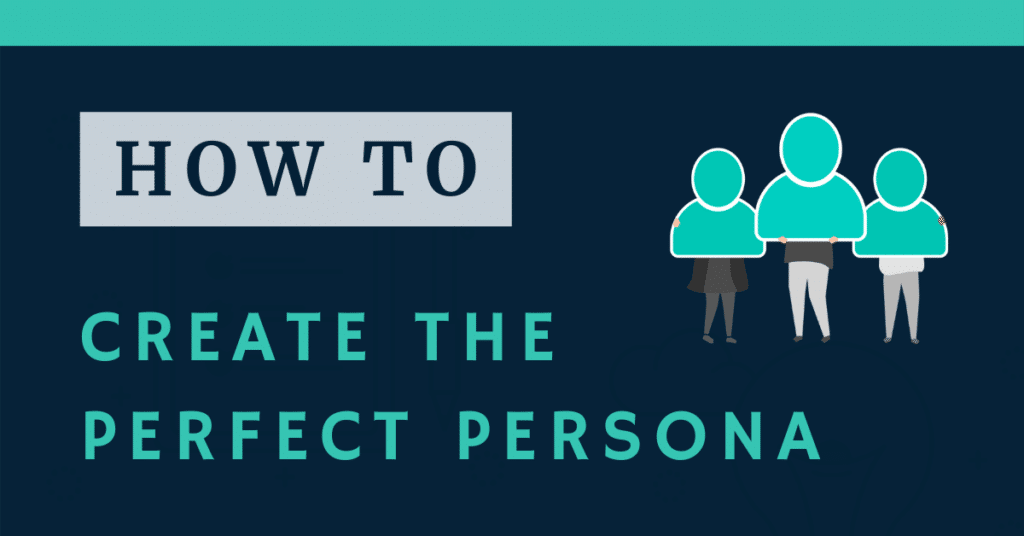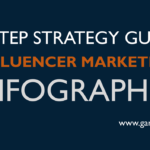A Persona will help your team to have a common understanding of a customer. This stops confusion in discussions, decisions and improves planning. As an example, when planning a marketing campaign, developing a website or designing a service.
Table of Contents
WHAT IS A PERSONA?
Quite simply, they provide help to give a group of customers a single easy to understand identity.
Treat different people differently. Anything else is a compromise.
Seth Godin
The way to think of a persona is as a representation of the common characteristics found within a group of people. As an example, you could develop a persona around people that collect butterflies.
But how do you put a persona together? Most personas are built from a mix of qualitative and quantitative research. Getting hold of the quantitative is easy but the qualitative can seem like a challenge. In this guide, I’ll show help you understand the main components and then show you how to create a persona.
WHO USES A PERSONA?
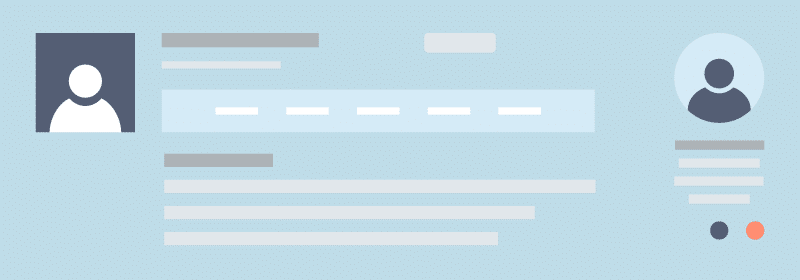
Most of the articles online revolve around personas in the context of design. In other words, UX designers defining an audience as part of a website project or app development.
However, personas have and can be used more broadly. The whole purpose of using a persona is to create a shared understanding that helps in making decisions.
For that reason, personas can be used across a wide range of industries to support decisions and to help shape strategies.
- Human Resources (HR). Personas can help HR teams define the profile of a person that they are recruiting for and why they would be a good fit for the organization.
- User Experience (UX) Designers. Personas are a core component of the goal-directed design. They help UX designers to focus on the interactions and how they help move a persona closer to their goal.
- Event Managers. Most events involve multiple sets of users who in turn have their own requirements. As an example, many events have VIP guests or customers. Designing communications and the event experience itself needs to take into consideration these different groups.
- Marketers. Customer Personas (B2C) or Buyer Personas (B2B) improve marketing performance. Marketing personas help teams to plan and shape marketing communications. Quite often they are based on a market segment.
- Content Designers. Designing content to effectively fit into customers journey helps with conversions. In essence, once a customer has been acquired you can use the persona to plan the funnel and what content will help inform, educate and influence the target persona. See the Growth Marketing Blueprint for more details.
- Customer Service. Customer service teams are often neglected or regarded as less important than marketing or sales. However, with more emphasis on retaining customers and solving problems once they are on board, their position in the company hierarchy has changed. Customer service teams are an invaluable source of information for insights on customers and helping to create personas.
- Customer Experience Designers. Designing and mapping experiences now have transitioned from being purely service design to integrating both product and service perspectives. Personas then are the start point for CX designers.
WHAT DATA DO YOU NEED FOR A PERSONA?
You need both quantitative and qualitative data for a persona.
Quantitative data is mostly statistical, e.g. the percentage of the population in an age range.
Data such as age, location or income are known as demographic data. Our age or income doesn’t help much on its own. What we often need to know is what interests people, what they value and what motivates them. The blend of data you need for a persona is drawn from the following:
- Demographic data tells us who that person is, e.g. age, income, location…
- Psychographic data tell us what they like, value and what they find interesting.
- Social data tell us how they interact and how they identify within social groups.
- Behavioral data tells us what they do and how they behave e.g. what they actually do, e.g. click, buy, watch…
To learn more read my article on customer segmentation methods.
A mistake often made by teams is to focus too heavily on quantitative research instead of integrating qualitative data, e,g, motivations.
WHAT ARE THE BENEFITS OF USING A PERSONA?
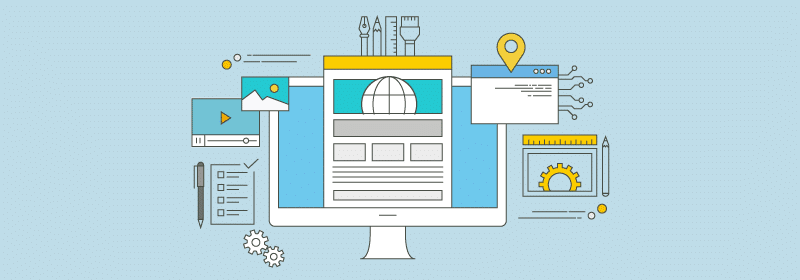
Every market is competitive, and every company faces competition for a customer. The fact is that customers have more choices than ever before.
It is easy to replicate products, harder to replicate services, but even harder still to replicate customer experiences. The challenge then is how the different parts of the business come together to deliver the customer experience.
Personas help people across divisions to identify with their customers. The two most effective methods to enable employees to understand the customer are User Stories and Personas.
The benefits of using a persona are:
- places a human face on what is just otherwise data
- helps to simplify complex ideas for teams
- develops a common mental model of a user
- provides insights into the key users
- helps align project teams with different types of users and possibilities
- improves communication within large agencies/organizations
- connects to other planning models such as the business model canvas
- experience delivers meaning and value to users
ARE PERSONAS EFFECTIVE?
How effective is a persona? Well, like many other tools and research, it depends.
It depends on how well the research is conducted, the sample size, how accurately the sample reflects the group and so on. Ultimately, it comes also comes down to time and cost, not just research rigour.
A poorly researched persona that is thrown together in a team meeting without any substantive research is unlikely to deliver any benefit and may even do more harm than good.
I have reviewed the academic literature and the papers generally support the use of personas. The following paper lists some of the main papers that relate to personas and the benefits highlighted from other research.
Paper: Personas and user-centered design: How can personas benefit product design processes? https://www.sciencedirect.com/science/article/abs/pii/S0142694X11000275?via%3Dihub
TABLE FROM THE PAPER
| Source | Benefit |
|---|---|
| Cooper (1999) | - Increase focus on the users and their goals |
| - Facilitate effective communication about users | |
| - Reduce necessary changes at the end of the development process | |
| Cooper and Reimann (2002) | - Build consensus and commitment to design |
| - Help to measure a design’s effectiveness | |
| - Define the product’s feature set | |
| - Facilitate effective communication within the project team | |
| - Help other related efforts such as marketing plans | |
| Grudin and Pruitt (2002) | - Facilitate a focus on users and work contexts |
| - Allow for extrapolation from partial knowledge of users to diverse contexts | |
| - Make assumptions about users explicit | |
| - Facilitate effective communication about the users | |
| - Increase focus on a specific audience | |
| Long (2009) | - Strengthen focus on the users during the development process |
| - Lead to more user-friendly designs | |
| - Make the user needs more explicit | |
| - Guide decision making | |
| Ma and LeRouge (2007) | - Facilitate effective communication about the users |
| - Enhance identification with the target users | |
| - Increase focus on user needs | |
| Pruitt and Adlin (2006) | - Make assumptions about users explicit |
| - Narrow the users being designed for | |
| - Lead to better design decisions | |
| - Increase engagement among the design team | |
| - Build empathy for the users |
IS THE PERSONA REDUNDANT?
There are lots of arguments as to why personas are not the ideal way to depict a group. Most of these involve the fact that the data is static and it doesn’t depict all of the many different nuances involved in how users within a group make decisions and behave.
Another well-documented difference is purely down to how each role views a project.
- A product manager is focused on getting a product to market and therefore budget and commercially focused.
- A marketer is aimed squarely at generating sales.
- A designer is tasked with making a product user-friendly, fit for purpose and aesthetically designed.
Quite often you have different perspectives of what a persona is and why it is needed. Marketing wants a ‘marketing persona’ to sell more stuff, whereas ‘design personas’ want to focus on the user behavior relevant for a product. Last but not least the development teams just want to know what to code and aren’t interested in a persona at all.
USING PERSONAS IN MULTI-DISCIPLINARY TEAMS
Bringing teams together and agreeing on a persona is an important part of any process. A common mental model of the user and the process helps everyone understand their role and fit to a project.
Development Teams
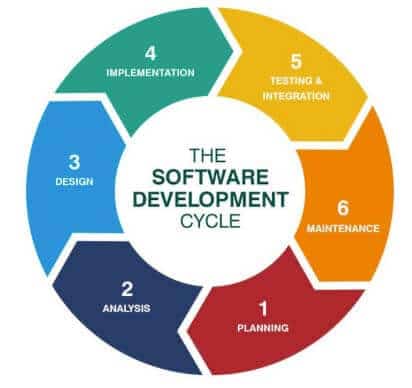
The Software Development Lifecycle (SDLC) is an iterative process that proceeds in a linear direction. It is either depicted as a 6 or 8 stage cycle that improves the solution until the solution is ready to go into production.
Agile approaches are used in the SDLC through an iterative process of refinement. Agile breaks a proposed deliverable into the smallest increments that add business value. If we take this framework understanding the user is important in steps 1 to 4. Step 4, in particular, is important but that is when you get feedback on well you have met a user’s needs.
Design Teams
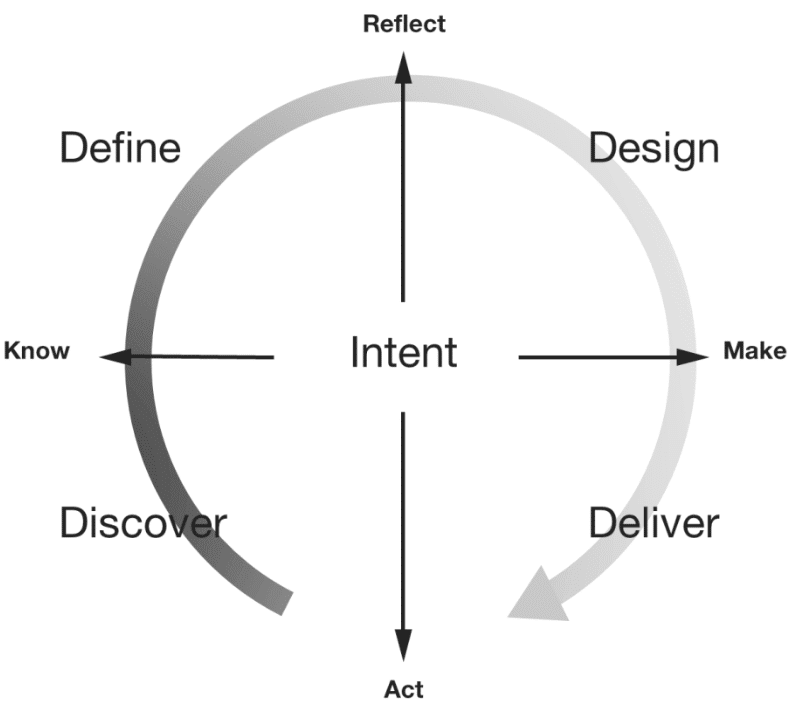
This framework of design thinking, originally published by Charles Owen also in 2005 (and later adapted by Vijay Kumar and Steve Sato), shows how discover is an act of knowing, to define is to know through reflection, design is to reflect by making, and deliver is the act of making.
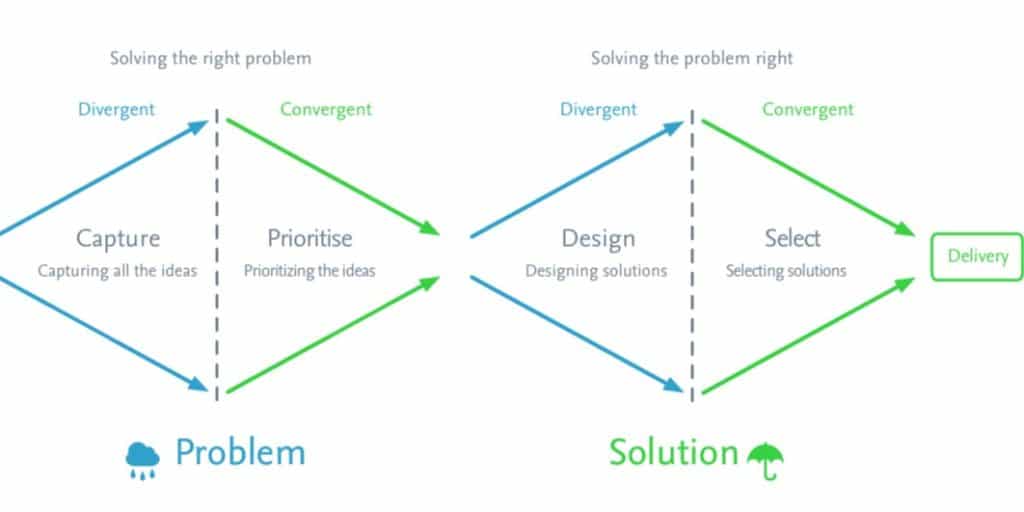
The Double Diamond Design Thinking approach splits into two sections the stages of development.
Although design traditionally focuses on the user in the first half, it is important to recognize the second stage of delivery and iteration.
The first half focuses on the questions:
- Is there a clear problem that we have identified?
- Is there a clear vision for what we must achieve?
Teams need to have a coherent vision and understanding of how their roles fit together. They have to identify with the bigger vision rather than just the frameworks they use and their daily tasks.
In the second half of the diamond, the team has to understand and relate to each other and be able to answer the questions:
- Is the vision scoped and broken down into achievable chunks?
- What are the features and how will they relate to the persona(s).
HOW DO PERSONAS WORK
Personas are effective because they leverage our innate ability to relate to people. In particular, through user stories, we are able to transport ourselves into their world and empathize with the problems they face.
The purpose of using a persona is to represent the whole person and not just rely heavily on ‘hard’ demographic data. People are complex and there are many different motivations, emotions, and reasons that relate to their behaviour.
Some of the ways that personas teams to be more effective:
- Narrative. Marketing, customer experience design and more generally user design often benefit from ‘user stories’. A narrative approach helps teams to design better products, experiences and communications.
- Concrete thinking. Personas can seem a bit abstract at times. Using real cases, experiences and feedback can bring clarity to a persona.
- Theory of mind. We know from research that people don’t make rational decisions about buying products. Reference: Buyology and Thinking Slow and Fast. The ability to understand another person’s beliefs, intents, desires, emotions, knowledge is critical to effectively designing products, services and experiences.
- Empathy. Our ability to understand, relate to and share the feelings of others provides us is the foundation to improve how we design, deliver and improve a business. When companies see customers as numbers and forget to see them as humans, they lose touch with the fundamental principles upon which the business is built.
- Experience-taking. Designing experiences, mapping current customer journey’s takes you into the customer’s world. Different segments, ‘personas’, experience different journeys. Personas help teams to move through the stages of a journey and realise why different segments require different interactions.
A persona, therefore, helps teams to construct a rich mental model of a user’s world.
HOW TO CREATE A PERSONA – STEP BY STEP GUIDE
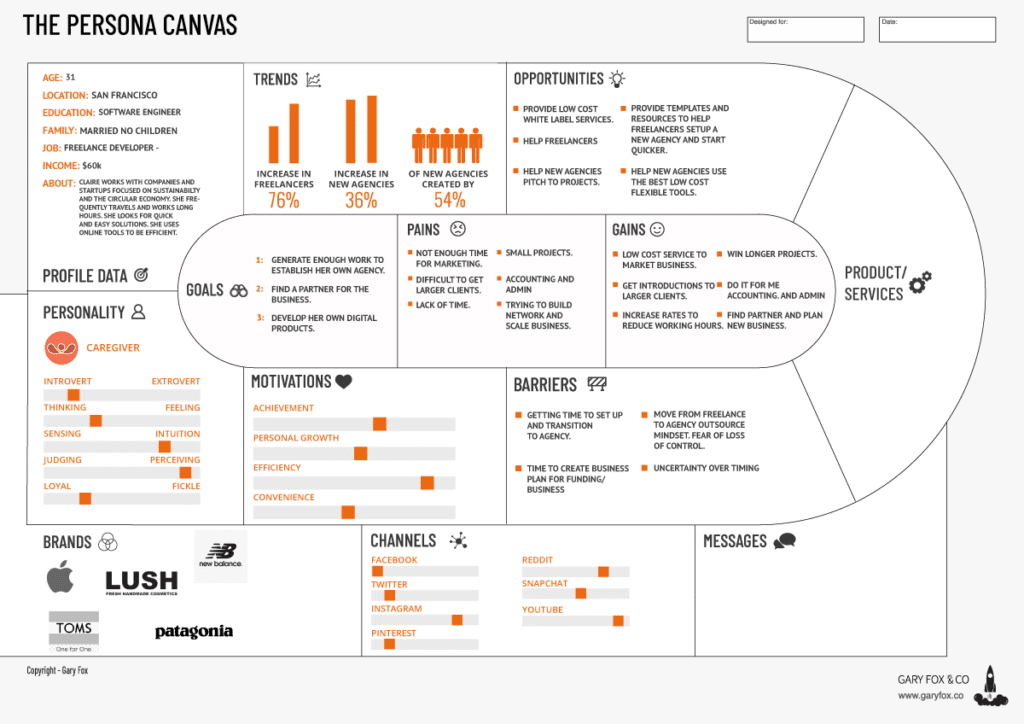
If a team hasn’t used personas before it can be a big change in thinking. Some people even feel uncomfortable with creating a persona and giving them characteristics. To overcome this use real-world examples and stories to provide examples, cases and evidence.
People often project their own opinions onto a persona. It is all too easy to let opinions, and not research, cloud the development of a persona. Be careful to validate the persona across the team to avoid this.
The primary purpose of personas is to bring clarity and focus to decisions.
In other words, use personas to spot themes, differences as well as similarities. See where there are common areas as well as reasons to differentiate your solution at different stages.
THE JOBS TO BE DONE FRAMEWORK
The Jobs-To-Be-Done framework transforms your approach to creating a persona. Instead of wallowing around in masses of data looking for an epiphany moment. Instead, you focus on what a customer is trying to achieve.
The Jobs-To-Be-Done (JTBD) framework asks you to focus on one specific question
What is this person trying to do?
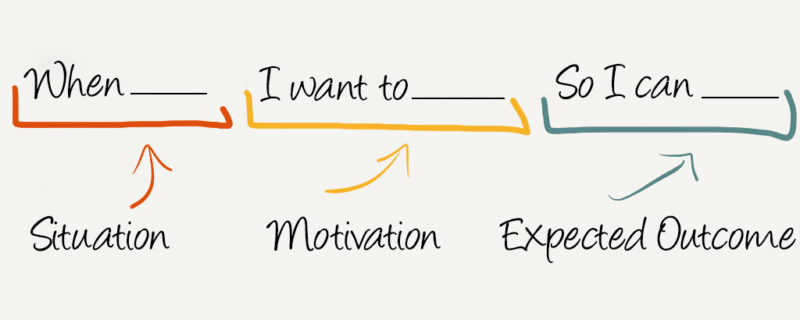
In the next sections, I’ll walk you through the main steps in creating a persona. It isn’t difficult and with practice, you will get better at creating and using them.
STEP 1. START WITH A SEGMENT
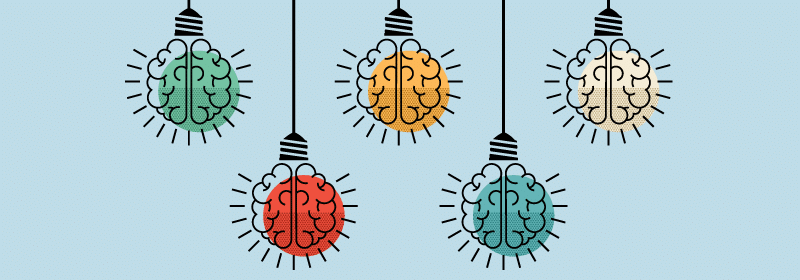
Although a customer segment can have more than one persona it is a good place to start.
- The work of defining some basics characteristics has already been done.
- You will some existing data that you can use.
If this is your first time using a segment then focus on trying to keep the number of personas to a minimum.
STEP 2. HARNESS YOUR EXISTING DATA
First of all, map the data that you need to create your persona. Much of this might already exist, but be scattered in different places.
After creating your list, list your sources next to each dataset. Usually, teams identify quantitative sources first. Generally, qualitative data is harder to find.
Quantitative Data Sources
- Google Analytics.
- Facebook.
- CRM systems.
- Census data.
- Market reports.
Qualitative Data Sources and Research Methods
- Online Questions.
- Keyword Research.
- Online Blogs/Forums and Bulletin Boards.
- Interview customers.
- Contextual Interviews.
- Market reports with behavourial trends.
- Surveys.
- Analyze Your Social Media Data.
- Observation/Ethnography.
Useful tools to use for your research:
If you’re new to getting qualitative data, these tools will help to simplify the process and get you started.
- A template to follow from jbtd.info.
- A guide for interviews – Mozilla’s toolkit for recruiting!
- Calendly to schedule reminders.
- Evernote for note-taking, editing, and sharing.
- Typeform for questionnaires.
- The Persona Canvas – a high-quality free printable pdf to stick post-it notes on.
Use qualitative data is to identify trends, patterns and themes amongst your segments.
EXAMPLE OF PERSONA PROFILE
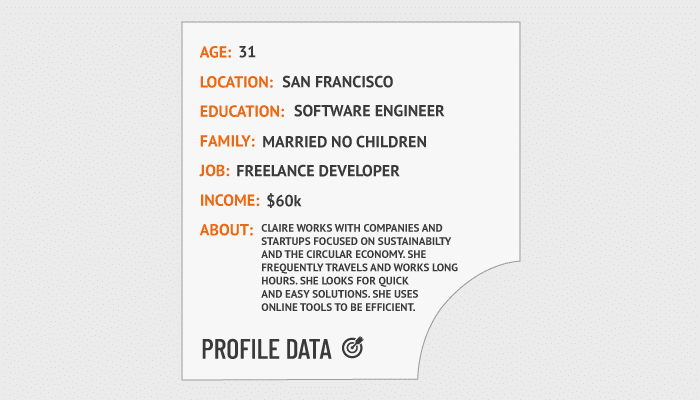
STEP 3. DEFINE PERSONA GOALS

Goals are what a person wants to do, achieve, or become. They are what people strive for. Of course, once they reach their goals they either stop, having achieved their goal, or go into maintenance mode.
Feeling smart, getting the best deal, and living the good life are all examples of goals. Many of these fit the universal needs setout in Maslow’s hierarchy of Needs.
A goal should be a simple set of bullet points.
Goals vary enormously. For instance, if you are in the BtoB market you might focus on a client’s work goals. Alternatively, if you are in the BtoC market you might focus on life goals. And, of course, experience goals work across both.
Work goals
- Marketer – I need to reduce churn, to improve automation, to improve data insights.
- HR Director – I need to spend less time moving data between systems, to reduce the time taken up with the recruitment process.
- European Business Development Director – I want to spend less time booking travel.
Life goals
- Retire – In the future, I want to retire early and have enough money to care for the family and travel.
- Travel – I want to explore Asia.
- Wealth – I want to have no debt and reduce my working week.
Experience goals
- Fun – at restaurant with friends.
- Refreshed – at yoga or meditation class.
- Safe – in hotel while travelling.
Experience goals describe how personas want to feel. Not every persona needs experience goals, but in some cases they are useful to include.
These goals are too broad and run the risk of being irrelevant. However, they are a start point. Ideally, you need to be narrow and focused on your customer segment.
EXAMPLE OF PERSONA GOALS
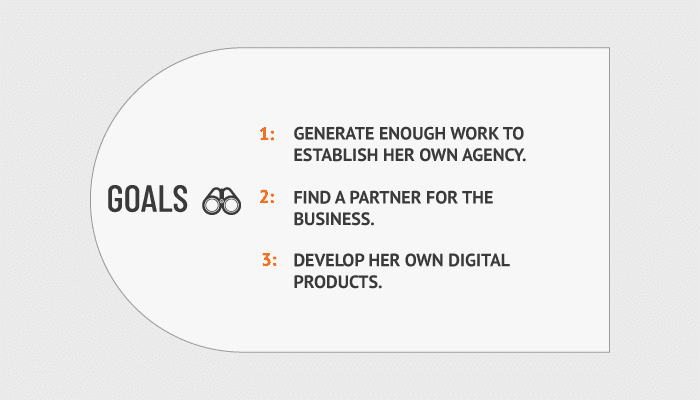
STEP 4. MOTIVATIONS AND PAIN POINTS
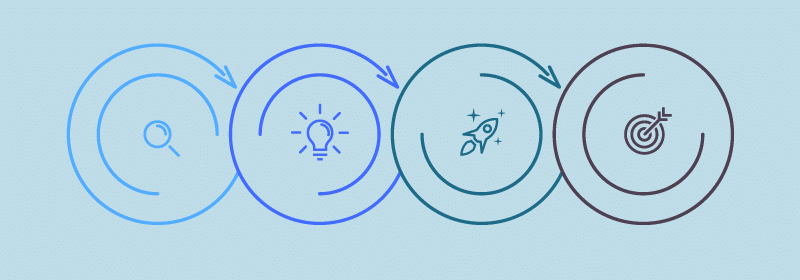
WHAT ARE PERSONA MOTIVATIONS?
Motivations are the drivers behind setting and pursuing goals. Motivation is why someone wants to do something. Fundamentally, it is what arouses and sustains action toward a desired goal. Motivation gives purpose and direction to behaviour.
Motivation directs behaviour toward increasing, decreasing, or maintaining a specific state. However, no single theory adequately explains all human motivation. Looking at individual theories gives us a better understanding.
An easy way to think of motivations is ‘towards’ and ‘away’. A towards motivation is associated with positive feelings and energy, whereas an away is all about avoidance. If you are considering a holiday it is associated with wanting positive emotions and emotions. On the opposite side, debt is associated with wanting to avoid.
These fit to our basic instincts for survival. We want to avoid danger and go toward situations that are positive for us.
MOTIVATION EXAMPLES
Towards
- Understanding
- Pleasure
- Control
- Certainty
- Inclusion (social)
- Pleasant consequences (reward)
- Achievements
- Likelihood of success
- Solutions to problems
- Security
Away
- Confusion
- Pain
- External restriction/control
- Uncertainty
- Deficiency
- Unpleasant consequences (punishment)
- Threats or risks
- Negative physical sensations (hunger, thirst, etc)
Knowing why someone has a particular goal provides us with a deeper understanding of their goal. Goals on their own are too simple, we need to understand motivation, the underlying ‘why’ of behaviour.
EXAMPLE OF PERSONA MOTIVATIONS
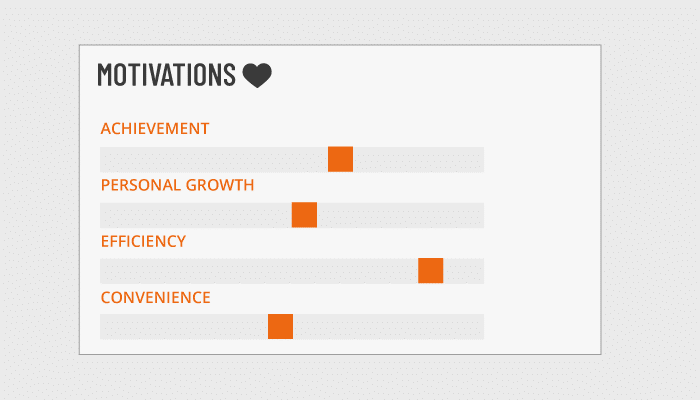
WHAT ARE CUSTOMER PAIN POINTS?
Like all of us, to get to a goal we must work through a series of tasks. These are the jobs to be done.
However, sometimes as we are trying to get things done there is no easy path, or we hit bumps because the information is hard to find, or we can’t get hold of the right person…
Instead of a smooth experience, we end up with frustrations. Frustrations are opportunities to make things better or to create new products and services.
EXAMPLES OF PAIN POINTS
Although you can think of pain points as simple problems, they’re often grouped into several broader categories. Here are the four main types of pain point:
- Financial Pain Points: people feel that their current product or solution is too expensive money and they want to reduce their spend.
- Productivity Pain Points: people feel that there a process is bloated inefficient and wastes their time.
- Process Pain Points: people feel that there is a better way and smarter way to get a task done, e.g. access information.
- Support Pain Points: people feel that the support they receive isn’t enough at critical stages of the customer journey or sales process.
HOW DO I IDENTIFY PAIN POINTS?
There are three ways to identify customers pains:
- Online research – e.g. reviews, forums and question sites like Quora.
- Qualitative Research – hold focus groups or invite customers in and ask them to show you their pain points.
- Talk to support teams and sales teams. Also, check your support tickets for common questions and themes.
EXAMPLE OF PAIN POINTS
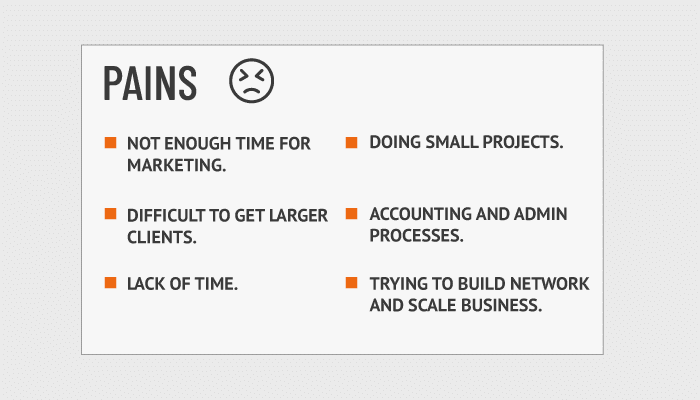
STEP 5. ARCHETYPES AND PERSONALITY
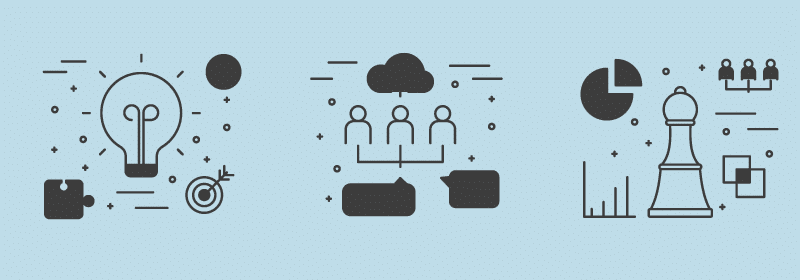
WHAT IS AN ARCHETYPE?
The most famous example of an archetype is the Hero. Hero stories have certain elements in common – heroes generally start out in ordinary circumstances, undertake an adventure, and then go onto confront their darkest fear in a conflict that transforms them.
Archetypes are widely understood identities that summarize a personality, motivations, and goals. Archetypes can help us to pick out key traits and personalities that we associate with a group of people. Care must be taken though not to use jargon and over-exaggerate some aspects of an archetype.
WHAT ARE THE 12 ARCHETYPES?
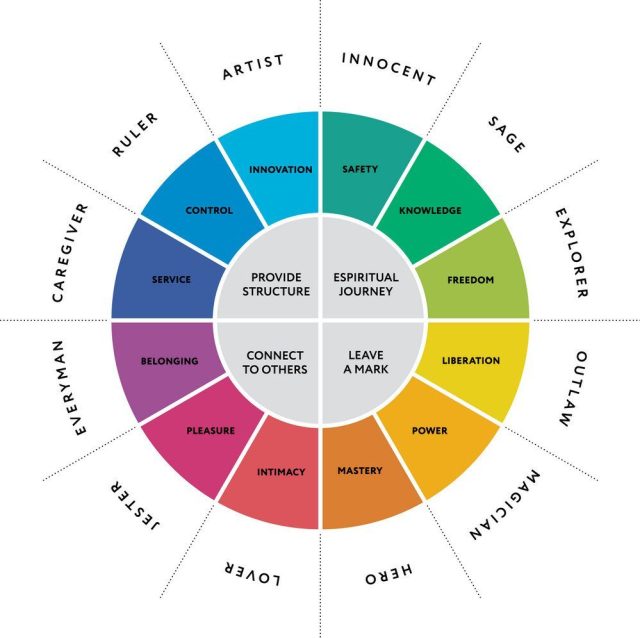
You can read more about archetypes here.
Another famous archetype approach is the Enneagram. My preference would be to use the 12 archetypes, but on a personal level, you may find the Enneagram test interesting for yourself.
There are other ways to add more details about your persona. As an example, you can use the Technology Adoption Model (TAM) to classify a group (Rogers 1962 5th ed, p. 283).
- Innovators (2.5%) – first individuals to adopt an innovation.
- Early Adopters (13.5%) – individuals who have the highest degree of opinion leadership.
- Early Majority (34%) – adopt an innovation after a varying degree of time.
- Late Majority (34%) – will adopt an innovation after the average member of society.
- Laggards (16%) – are the last to adopt an innovation.
WHAT IS A PERSONA PERSONALITY
Who is your user? Write down 3-5 bullet points about their personality to build out their profile.
If you work for a large organization then you probably are already familiar with Myers Briggs. Based on their model, there are 16 potential user personality types.
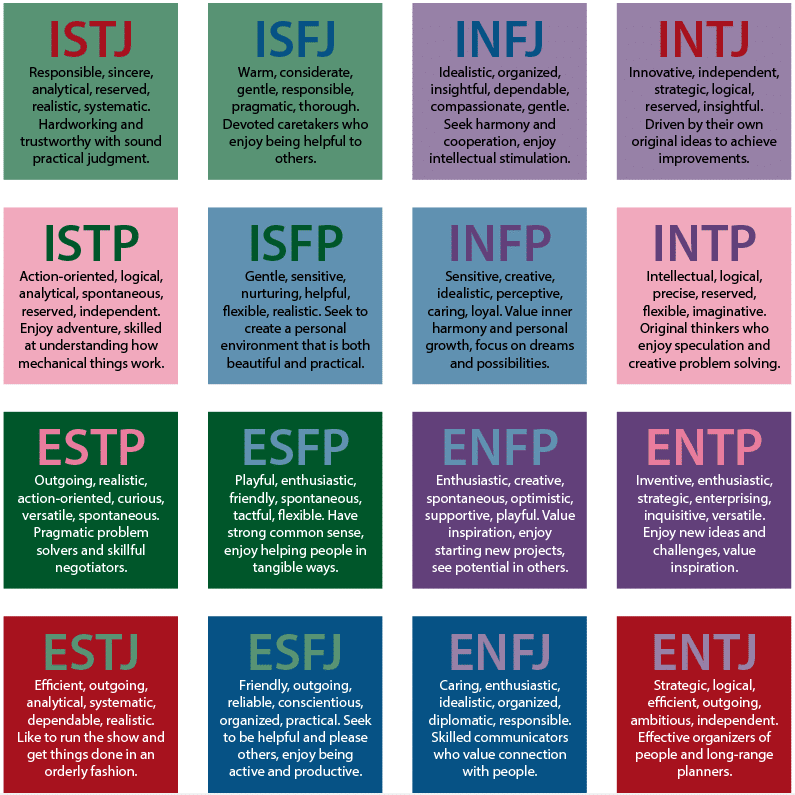
You can take the online personality test to find out your own personality. The way to use this is to highlight, in a simple way, where on the Myers Brigg scale your persona sits.
See the Persona Canvas for examples of how to use this and on how to create a persona.
PERSONALITY TRAITS
What are your persona’s core traits – on a scale?
There is increasing evidence that we all have degrees of what is known as the big five traits. Research for this has mounted over the years: D. W. Fiske (1949), Norman (1967), Smith (1967), Goldberg (1981), and McCrae & Costa (1987).
The “big five” are broad categories of personality traits. A useful way to remember them is by using the acronym OCEAN (openness, conscientiousness, extraversion, agreeableness, and neuroticism).
In the real world, most people lie somewhere in between the two polar ends of each trait. Think of it as a spectrum rather than extremes. For example, extraversion represents a continuum between extreme extraversion and extreme introversion.
If you’re interested in finding out more you can read about the traits here.
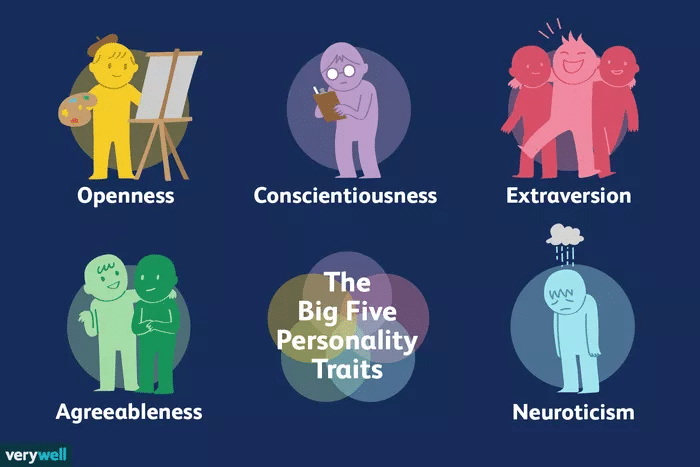
Example of PERSONA archetype and personality traits
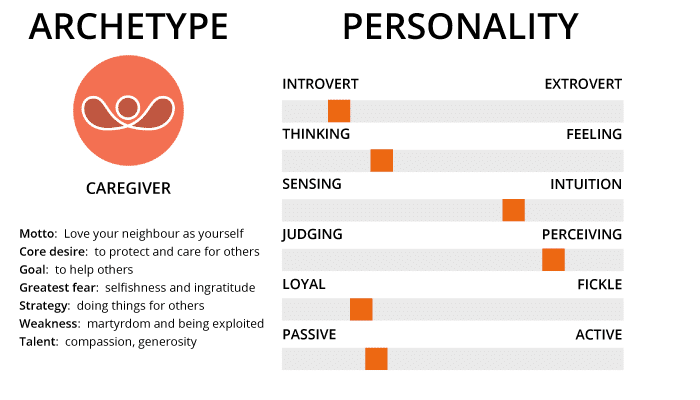
STEP 6. MARKET TRENDS
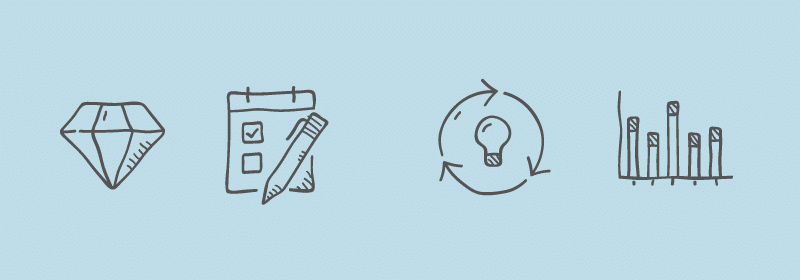
aaa
In a world of change, the learners shall inherit the earth, while the learned shall find themselves perfectly suited for a world that no longer exists.
Eric Hoffer
WHY MARKET TRENDS ARE IMPORTANT
Markets change. Customers change. Hopefully, you will track and monitor the key trends in your market to account for this when making decisions about your customers.
At any one time, some trends are clearly more dominant and influential than others. The aim of including trends in your persona is to capture the trends that are influencing them.
An easy to think of these trends is to use PESTLE.
- POLITICAL
- ECONOMIC
- SOCIAL
- TECHNOLOGICAL
- LEGAL
- ENVIRONMENTAL
Design, behaviours and media are examples of other types of trends you can use.
HOW TO FIND MARKET TRENDS
If all you are after is top-line investigation then use Google trends.
Market reports can be expensive, very expensive. If you want to get top-line details I would search on trends and see what blogs by organizations offer. Another trick is to search on a report and then look in Google images. Quite often organizations post image snippets of reports in their site that turn up on Google.
For full reports and more detailed trends, you can use these sites.
EXAMPLE PERSONA MARKET TRENDS
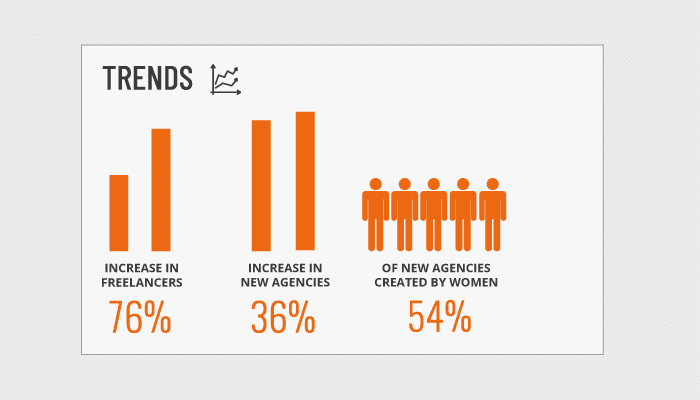
STEP 7. NAME, IMAGE AND QUOTE
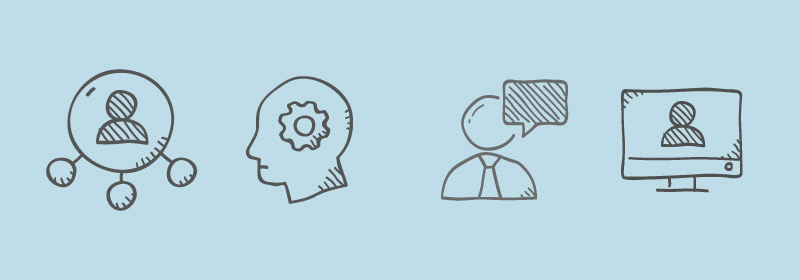
This is a nice and easy part. We can now add an image (stock photo), give the persona a name and pull together a quote.
Images are worth a thousand words. Giving your persona a face helps to humanize it.
When choosing an image match it to your persona’s age, gender, and personality. Other things to consider is the setting and their style of dress. Are they an executive for a large organization or a freelance consultant?
My favourite place for free stock photos is Unsplash. Search on either “persona” or some descriptors that match your persona.
STEP 8. BARRIERS

Underestimating barriers is one of the biggest mistakes made when creating a new product, service or even a marketing campaign.
As an example, people don’t switch banks very often, despite the fact that they poorly rate their bank’s service levels. The reason for this is that traditionally the difficulty and time taken to swap banks was huge. In other words, there were significant barriers.
Other forms of barriers include:
- Habits – changing people’s habits – asking them to do things differently without them understanding the value of the change.
- Process – change the way people do things, e.g. adopting a new tool in their workflow. Often people have a huge amount of time invested in knowing how a tool works (pros and cons).
- Social – changing a location or situation can mean that people might need to change a routine or move to an unfamiliar situation.
When considering all the positive options it is important to assess any barriers.
STEP 9. USE IT
The worst use of a persona is simply to not use it.
Pin it on your wall, have it visible on your desk, schedule a meeting to review its use and what needs updating.
Don’t put time and effort into creating and then simply leave it to one side. Refer back to it for decisions.
Analyze your different user personas, try to have at least one similar metric between them. Otherwise, you’re going to compare really abstract things like their bio.
Something like a score or point can generally be compared across the board.
STEP 10. ADAPT IT
First-time personas often need adjusting.
Take time to change and adapt it based on what happens.
If it doesn’t work maybe you are trying to use one persona for two distinct groups or segments.
Look at the data and figure out if there are significant differences in the group that warrant producing two personas.
FREE PERSONA CANVAS DOWNLOAD
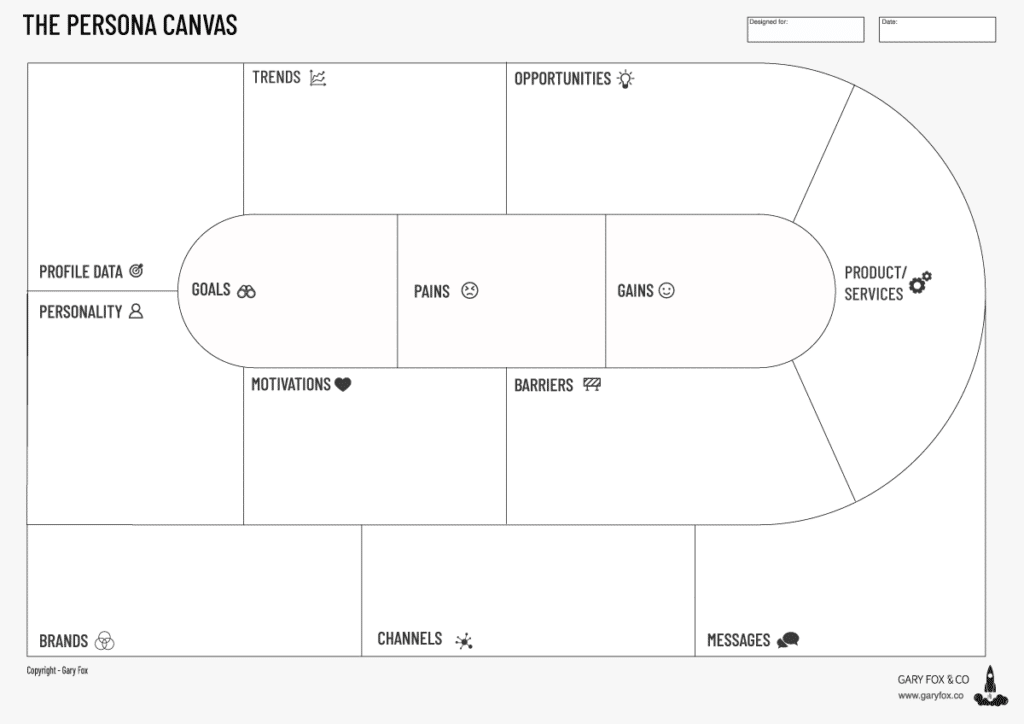
If you are working in a team and producing a persona or updating it then you can download free persona canvas. There are two versions. The oval one and a square one. I would be interested in hearing which one works best for you.
